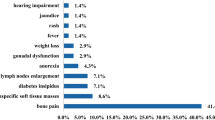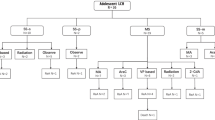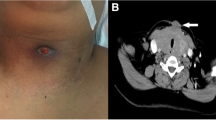Abstract
The present study aims to evaluate the characteristics and treatment outcomes of adult Langerhans cell histiocytosis (LCH) patients with thyroid involvement. We retrospectively described the clinical, biological, and genomic characteristics of a series of 36 LCH patients with thyroid involvement in our center between January 2001 and December 2021. At the time of diagnosis, only one patient was classified as having single-system LCH, and 35 patients were classified as having multisystem (MS) LCH. Three patients had coexisting papillary thyroid carcinoma. Patients with thyroid gland involvement had higher frequencies of pituitary (88.6% vs. 53.4%, P < 0.001), liver (45.7% vs. 20.7%, P = 0.003), and lymph node (54.3% vs. 31.6%, P = 0.012) involvement and a lower frequency of bone (45.7% vs. 72.0%, P = 0.003) involvement than patients without thyroid gland involvement. Sixteen patients had abnormal thyroid function, including nine patients with primary hypothyroidism, one patient with central hypothyroidism, and six patients with subclinical hypothyroidism. BRAFV600E, BRAF N486_P490, and MAP2K1 mutations were detected in 14.3%, 57.1%, and 7.1% of patients, respectively. After a 43-month median follow-up, none of the patients died, and 15 patients experienced reactivation. The median event-free survival was 37.5 months. Two of 6 patients with subclinical hypothyroidism had normal thyroid function, and 12 patients still had hypothyroidism after treatment. As the largest adult LCH cohort with thyroid gland involvement to date, we found that patients with thyroid gland involvement had different clinical characteristics, genetic profiles, and outcomes than patients without thyroid gland involvement.

Similar content being viewed by others
References
Emile JF, Abla O, Fraitag S et al (2016) Revised classification of histiocytoses and neoplasms of the macrophage-dendritic cell lineages. Blood 127(22):2672–2681
Arico’ M, Girschikofsky M, Genereau T, et al (2003) Langerhans cell histiocytosis in adults: report from the International Registry of the Histiocyte Society. Eur J Cancer. 39:2341–2348
Patten DK, Wani Z, Tolley N (2012) Solitary Langerhans histiocytosis of the thyroid gland: a case report and literature review. Head Neck Pathol 6:279–289
Sahoo M, Karak AK, Bhatnagar D, Bal CS (1998) Fine needle aspiration cytology in a case of isolated involvement of thyroid with Langerhans cell histiocytosis. Diagn Cytopathol 19:33–37
Cao XX, Duan MH, Zhao AL, Cai H, Chen J, Gao XM et al (2022) Treatment outcomes and prognostic factors of patients with adult Langerhans cell histiocytosis. Am J Hematol 97(2):203–208
Moschovi M, Adamaki M, Vlahopoulos S, Rodriguez-Galindo C (2015) Synchronous and metachronous thyroid cancer in relation to Langerhans cell histiocytosis; involvement of V600E BRAF- mutation? Pediatr Blood Cancer 62(1):173–174
Vergez S, Rouquette I, Ancey M et al (2010) Langerhans cell histiocytosis of the thyroid is a rare entity, but an association with a papillary thyroid carcinoma is often described. Endocr Pathol 21:274–276
Badalian-Very G, Vergilio JA, Degar BA, MacConaill LE, Brandner B, Calicchio ML et al (2010) Recurrent BRAF mutations in Langerhans cell histiocytosis. Blood 116(11):1919–1923
Nelson DS, van Halteren A, Quispel WT, van den Bos C, Bovee JV, Patel B et al (2015) MAP2K1 and MAP3K1 mutations in Langerhans cell histiocytosis. Genes Chromosomes Cancer 54(6):361–368
Chakraborty R, Burke TM, Hampton OA, Zinn DJ, Lim KP, Abhyankar H et al (2016) Alternative genetic mechanisms of BRAF activation in Langerhans cell histiocytosis. Blood 128(21):2533–2537
Chen J, Zhao AL, Duan MH, Cai H, Gao XM, Liu T et al (2022) Diverse kinase alterations and myeloid-associated mutations in adult histiocytosis. Leukemia 36(2):573–576
Abdullah MI, Junit SM, Ng KL, Jayapalan JJ, Karikalan B, Hashim OH (2019) Papillary thyroid cancer: genetic alterations and molecular biomarker investigations. Int J Med Sci 16(3):450–460
Ascierto PA, Kirkwood JM, Grob JJ, Simeone E, Grimaldi AM, Maio M et al (2012) The role of BRAF V600 mutation in melanoma. J Transl Med 10:85
Swerdlow SH, Campo E, Harris NL et al (2017) WHO classification of tumours of haematopoitetic and lymphoid tissues. IARC PRESS, Lyon
Cao XX, Li J, Zhao AL, He TH, Gao XM, Cai HC et al (2020) Methotrexate and cytarabine for adult patients with newly diagnosed Langerhans cell histiocytosis: a single arm, single center, prospective phase 2 study. Am J Hematol 95(9):E235–E238
Duan MH, Han X, Li J, Zhang W, Zhu TN, Han B et al (2016) Comparison of vindesine and prednisone and cyclophosphamide, etoposide, vindesine, and prednisone as first-line treatment for adult Langerhans cell histiocytosis: a single-center retrospective study. Leuk Res 42:43–46
Zaidi A, Gautam U, Srinivasan R et al (2020) Challenging diagnosis of two neoplasms, Langerhans cell histiocytosis and papillary thyroid carcinoma, from fine needle aspiration of the thyroid by cell-block immunocytochemistry and molecular testing for BRAF V600E mutation. Cytopathology 31(6):598–601
Al Hamad A, M, Albisher HM, Al Saeed WR, et al (2019) BRAF gene mutations in synchronous papillary thyroid carcinoma and Langerhans cell histiocytosis co-existing in the thyroid gland: a case report and literature review. BMC Cancer. 19(1):170
Acknowledgements
The authors thank the patients and their families. This work was supported by institutional research funding provided by the Non-profit Central Research Institute Fund of the Chinese Academy of Medical Sciences (Grant No. 2019-RC-HL-001 to CXX) and the Beijing Natural Science Foundation (Grant No. 7202160 to CXX).
Author information
Authors and Affiliations
Corresponding author
Additional information
Publisher's Note
Springer Nature remains neutral with regard to jurisdictional claims in published maps and institutional affiliations.
Rights and permissions
About this article
Cite this article
Cai, Hc., Liu, T., Cai, H. et al. Adult Langerhans cell histiocytosis with thyroid gland involvement: clinical presentation, genomic analysis, and outcome. Ann Hematol 101, 1925–1929 (2022). https://doi.org/10.1007/s00277-022-04894-9
Received:
Accepted:
Published:
Issue Date:
DOI: https://doi.org/10.1007/s00277-022-04894-9




